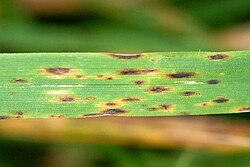| Pleosporaceae | |
|---|---|
 | |
| Cochliobolus sativus | |
| Scientific classification | |
| Domain: | Eukaryota |
| Kingdom: | Fungi |
| Division: | Ascomycota |
| Class: | Dothideomycetes |
| Order: | Pleosporales |
| Family: | Pleosporaceae Nitschke (1869) [1] |
| Synonyms | |
Pyrenophoraceae | |
Pleosporaceae is a family of sac fungi. They are pathogenic to humans or saprobic on woody and dead herbaceous stems or leaves. [2]
Contents
They are generally anamorphic species (having an asexual reproductive stage). [3] The type species is Stemphylium botryosum Wallr. [2]
They have a cosmopolitan distribution worldwide. [4]